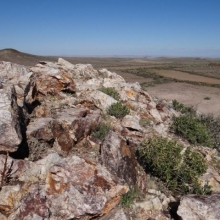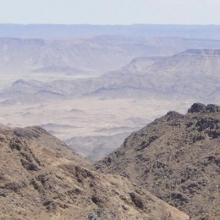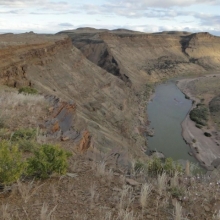Geology
Geological History
The Namaqua Complex originated as layers of sediments and volcanic rocks deposited more than 1800 million years ago in a shallow sea. After deposition they were buried to a depth exceeding 20 km by the slow accumulation of more sediment. During this process they were intruded by granitic magma and transformed under high pressures and temperatures to gneiss, amphibolite, schist and granulite (ca. 1200 m. y. ago). Some 770 m. y. ago these metamorphic rocks were invaded by doleritic magma which formed prominent dark dykes that can be seen in the canyon walls. Another 300 m. y. later the Namaqua rocks once more became exposed on the Earth´s surface through erosion of the overlying strata to form the floor of another shallow sea in which the sandstone, shale and limestone of the Nama Group were laid down. As no major phase of deformation or metamorphism followed their deposition, these rocks today are still nearly horizontal and have preserved their original sedimentary structures - thus forming a sharp contrast to the underlying massive Namaqua metamorphic rocks.
Ca. 350 m.y. before present erosion had removed most of the Nama rocks and the initial river valley had formed as a wide depression. During the Dwyka glaciation it was deepened by south flowing glaciers, and eventually filled up by glacial sediments, sandstone and shale of the Karoo Sequence. Today’s canyon began to form during post-Karoo uplift of the new-formed African continent. During this period the glacial deposits were nearly completely eroded; the rocks exposed today in and around the Fish River Canyon belong to the Namaqua Metamorphic Complex, with only the lower portion of the Nama Group (sandstone and black limestone) preserved in the vicinity of the Canyon.
Story of a River
The Fish River rises between Rehoboth and Maltahöhe. For the first 450 km of its course (overall length approximately 650 km) its gradient is comparatively low and it flows within a broad valley. Only ca. 50 km south of Seeheim, downstream of the confluence with the Löwen River, the gradient increases, causing the Fish River to incise more strongly into the underlying rocks. Initially it must have flown slowly over a flat land surface where it could meander freely as shown by its numerous bends, but continental uplift after the break-up of Gondwanaland ca. 130 m.y. ago resulted in the deep incision of the river into this surface to its present day level. At first, it cut through the horizontal layers of the Nama sediments, but later reached the underlying gneisses, amphibolites and migmatites of the Namaqua Complex. The same uplift created disturbances in the earth´s crust as evidenced by the bordering faults in the northern upper canyon along which the valley subsided.
While the upper canyon (8 km wide, 160 to 190 m deep) thus is a tectonic trough, the southern lower canyon (5 km wide, 460 to 550 m deep) was simply incised into the Nama and Namaqua rocks. From the first waterfall north of the northernmost viewpoint, to a point opposite the Chudaub trigonometrical beacon, the canyon is 56 km long; the Fish River hiking trail follows the river course for 85km from the main view point near Hobas to Ai-Ais Hot Springs.
Located at the southern end of the Fish River Canyon the recently refurbished Ai-Ais Hot Springs Spa is a veritable oasis in the middle of a grandiose mountain scenery teeming with wildlife and birdlife, which is part of the Ai-Ais/Richtersveld Transfrontier Park. The sulphate and fluoride-rich hot spring, which is supposed to have natural curative properties, was discovered in 1850 by a Nama shepherd searching for his lost sheep (Ai-Ais meaning “burning water” in the local Nama language).
Hot Springs
Along the fault zones forming the canyon sides groundwater rises to the surface to create a number of hot springs. The two best known are Ai-Ais (60°C) and, a little upstream, Sulphur Spring (56°C).
Source: Ministry of Mines and Energy
Relevant literature
-
An earth science review of the Orange-Fish River Basin, Namibia
Swart, R. 2008. An earth science review of the Orange-Fish River Basin. Report produced for the Ephemeral River Basins in Southern Africa (ERB) Project, Desert Research Foundation of Namibia (DRFN): Windhoek
» Download -
The Fish River Subgroup in Namibia: stratigraphy, depositional environments and the Proterozoic-Cambrian boundary problem revisited
Geyer, G. 2005. The Fish River Subgroup in Namibia: stratigraphy, depositional environments and the Proterozoic-Cambrian boundary problem revisited. Geological Magazine 142(05): 465–498
The Fish River Subgroup of the Nama Group, southern Namibia, is restudied in terms of lithostratigraphy and depositional environment. The study is based on partly fine-scaled sections, particularly of the Nababis and Gross Aub Formation. The results are generally in accordance with earlier studies. However, braided river deposits appear to be less widely distributed in the studied area, and a considerable part of the formations of the middle and upper subgroup apparently were deposited under shallowest marine conditions including upper shore-face. Evidence comes partly from sedimentary features and facies distribution, and partly from trace fossils, particularly Skolithos and the characteristic Trichophycus pedum. Environmental conditions represented by layers with T. pedum suggest that the producer favoured shallow marine habitats and transgressive regimes.» Download -
Trace fossils from the Nama Group (Precambrian-Cambrian) of southwest Africa (Namibia)
Crimes, T.P. and Germs, G.J.B. 1982. Trace fossils from the Nama Group (Precambrian-Cambrian) of southwest Africa (Namibia). Journal of Paleontology 56(4): 890–907
The late Precambrian to Early Cambrian Nama Group of southwest Africa (Namibia) has yielded additional trace fossils. The succession is divided, in ascending order, into the Kuibis, Schwarzrand and Fish River Subgroups. In the Kuibis Subgroup Bergaueria sp. is recorded. In the Schwarzrand Subgroup Brooksella sp., ?Chondrites sp., Diplocraterion sp., Nereites sp., and Skolithos sp. occur near the base while ?Diplichnites sp., Neonereites biserialis Seilacher, 1960 and N. uniserialis Seilacher, 1960 occur only high up, in the Nomtsas Formation. The Fish River Subgroup has yielded Enigmatichnus africani n. ichnogen., n. ichnosp., Phycodes cf. P. pedum Seilacher 1955 and Skolithos sp. On the basis of this material and the trace and body fossils described by Germs (1972a, b, c; 1973a, b) it is inferred that the Kuibis Subgroup is most probably Vendian, the Schwarzrand Subgroup below the Nomtsas Formation may be Vendian or Tommotian, while the Nomtsas Formation and Fish River Subgroup are at least as young as Tommotian and may be partly or entirely younger. Many of the trace fossils from low in the succession are exceptionally small. This may prove to be of stratigraphical significance but trace fossil dwarfing can result from unfavorable environmental conditions in rocks of any age.» Download






